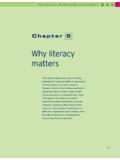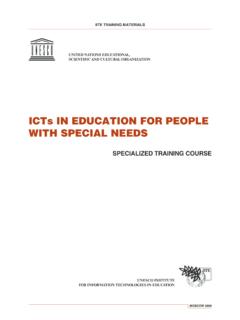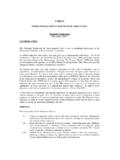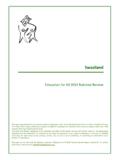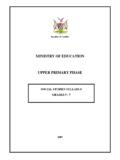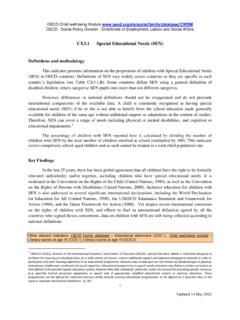Transcription of Applied Technologies in Municipal Solid Waste …
1 unesco EOLSSSAMPLE CHAPTERSWATER AND WASTEWATER TREATMENT Technologies - Applied Technologies in Municipal Solid Waste landfill leachate Treatment - Huu-Hao Ngo, Wenshan Guo, Wen Xing Encyclopedia of Life Support Systems(EOLSS) Applied Technologies IN Municipal Solid Waste landfill leachate TREATMENT Huu-Hao Ngo Faculty of Engineering and Information Technology, School of Civil and Environmental Engineering, University of Technology Sydney, Australia Wenshan Guo Faculty of Engineering and Information Technology, School of Civil and Environmental Engineering, University of Technology Sydney, Australia Wen Xing Faculty of Engineering and Information Technology, School of Civil and Environmental Engineering, University of Technology Sydney, Australia Keywords: landfill leachate , conventional treatment Technologies , advanced treatment Technologies Contents 1.
2 Introduction 2. leachate Characteristics and Its Discharge Limits leachate Characteristics leachate Discharge Standards 3. Problems and Environmental Impacts of landfill leachate Organic Matter Nutrients Heavy Metals 4. Typical landfill leachate Treatment Technologies Conventional Treatment Technology Physico-chemical Treatment Biological Treatment Advanced Treatment Technology Integration of Physical and Chemical Processes Integration of Biological Processes (including built-in membrane configuration) Integration of Physico-chemical and Biological Processes 5. Conclusion Acknowledgements Glossary Bibliography Biographical Sketches Summary This chapter illustrates the Municipal Solid Waste landfill s characteristics and discharge standard, its pollution problems and environmental impacts, and its typical Applied solution Technologies .
3 The Applied treatment Technologies are discussed based on two main catalogues of conventional and advanced Technologies . The conventional Technologies include: (i) physico-chemical (coagulation-flocculation, chemical unesco EOLSSSAMPLE CHAPTERSWATER AND WASTEWATER TREATMENT Technologies - Applied Technologies in Municipal Solid Waste landfill leachate Treatment - Huu-Hao Ngo, Wenshan Guo, Wen Xing Encyclopedia of Life Support Systems(EOLSS) precipitation, activated carbon adsorption, ion exchange, membrane filtration, chemical oxidation etc.); (ii) biological (aerobic or anaerobic conditions, suspended-growth or attached-growth conditions, and fixed-bed or moving-bed conditions). The advanced Technologies are introduced to three integration groups of (i) physicochemical, (ii) multi-biological, and (iii) physicochemical-biological processes.
4 1. Introduction One of the major pollution problems caused by the Municipal Solid Waste (MSW) landfill is landfill leachate , which is generated as a consequence of precipitation, surface run-off, and infiltration or intrusion of groundwater percolating through a landfill , biochemical processes in Waste s cells and the inherent water content of wastes themselves. After a landfill site is closed, a landfill will continue to produce contaminated leachate and this process could last for 30-50 years. Generally, leachate may contain large amounts of organic matter (biodegradable, but also refractory to biodegradation), as well as ammonia-nitrogen, heavy metals ( copper, iron, zinc, lead, manganese etc.), chlorinated organic and inorganic salts ( chloride, sulfate, sodium etc.)
5 , which are a great threat to the surrounding soil, groundwater and even surface water (Renou et al., 2008; Robinson, 2005). The composition of landfill leachate is not ubiquitous and varies with different sites and environmental conditions, depending on the nature of the deposited wastes, on soil characteristics, rainfall patterns and on the age of the landfill (Iaconi et al., 2006; Park et al., 2001). The landfill leachate creates the potential to contaminate ground water and surface water supply, and threaten human health when migrating from the landfill and contaminates the surrounding lands and water. With the growth of population and development of the industry, the landfill leachate problem becomes increasingly serious.
6 According to the survey of United States Environmental Protection Agency (USEPA), there are about 55,000 landfills in the USA, approximately 75 percent of which are polluting groundwater (USEPA, 2004). The cases of water polluted by landfill leachate have also been found globally, especially in European countries, Australia and China. Generally, the best way of controlling the pollution of environment by the landfill leachate is treating leachate to remove the hazardous components before it enters the water systems. The reason is that once the leachate enters the water bodies, it is very expensive and difficult to clean up the contaminated water. There are two leachate management strategies used by modern Municipal landfills.
7 These two processes are leachate recirculation and single pass leaching (Scott et al., 1994). The recirculation of leachate (including leachate containment, collection, and recirculation) is appropriate for landfill located in warm areas with low rainfall, and the benefits of this method are simplicity of operation and low operation costs. On the other hand, the single pass leaching strategy is Applied to most landfills where the generated leachate is collected and treated to remove most of the contaminants before it is discharged. Characterization and treatment of landfill leachate has only taken place within the last 40 years. The main applicable methods are physical, chemical and biological. Since it is difficult to obtain satisfactory effluent quality by using anyone of those methods alone, a combination of physical, chemical and biological methods are employed for efficacious treatment of landfill leachate (Kargi and Pamukoglu, 2004a; Uygur et al.)
8 , unesco EOLSSSAMPLE CHAPTERSWATER AND WASTEWATER TREATMENT Technologies - Applied Technologies in Municipal Solid Waste landfill leachate Treatment - Huu-Hao Ngo, Wenshan Guo, Wen Xing Encyclopedia of Life Support Systems(EOLSS) 2004). In the physical treatment Technologies used for landfill leachate treatment, air-stripping, adsorption and membrane filtration are the major ones. Coagulation-flocculation, chemical precipitation and oxidation are the common chemical leachate treatment methods. Meanwhile, biological treatment Technologies consist of aerobic, anoxic and anaerobic processes, which are widely employed for biodegradable contaminants removal from landfill leachate . 2. leachate Characteristics and its Discharge Standards leachate Characteristics landfill leachate consists of a number of complex factors, including Solid Waste composition, age of the Waste , operation of the landfill , hydrogeological conditions in vicinity of the landfill site, rate of the water movement through the Waste , landfill temperature, moisture content, pH, landfill chemical and biological activities and seasonal weather variations (Westlake, 1995; McArdle et al.
9 , 1988). The production of leachate also varies widely through the successive aerobic, acetogenic, methanogenic and stabilization stages. Table 1 gives the definition of three types of leachates according to landfill age (Renou et al., 2008). The typical chemical concentrations in young and old landfill leachates comparing with sewage and groundwater are also shown in Table 2 (McBean et al., 1995). Parameter Young Intermediate Old Age (years) < 5 5 10 >10 pH > COD (mg/L) >10,000 4,000 10,000 <4,000 BOD5/COD > < Organic compounds 80% volatile fat acids (VFA) 5 30% VFA + humic and fulvic acids Humic and fulvic acids Heavy metals Low medium Low Low Biodegradability Important Medium Low Table 1 landfill leachate classification vs.
10 Age Parameter Young leachate concentration (mg/L) Old leachate concentration (mg/L) Ty p i c a l sewage concentration (mg/L) Ty p i c a l groundwater concentration (mg/L) COD 20,000 40,000 500 3,000 350 20 BOD5 10,000 20,000 50 100 250 0 TOC 9,000 15,000 100 1,000 100 5 unesco EOLSSSAMPLE CHAPTERSWATER AND WASTEWATER TREATMENT Technologies - Applied Technologies in Municipal Solid Waste landfill leachate Treatment - Huu-Hao Ngo, Wenshan Guo, Wen Xing Encyclopedia of Life Support Systems(EOLSS) Volatile fatty acids (as acetic acid) 9,000 25,000 50 100 50 0 Table 2 Typical chemical concentrations in landfill leachate comparing with sewage and groundwater La n d fill Parameter(mg/L) LHWMC (NSW)Olympic Park (NSW)*Rus s e ll Va le (NSW)Lyndhurst (VIC)SummaryAge (year)2-1264 p 21850-73050-14000 BOD512-11400 ( S/cm)6000-2200017700-23100 270-22000240-23100 Temperature (oC)15-34 36-3815-38SS25-605 10400-13900 270-14000270-14000 TOC135-6200 59-270059-6200 TKN 1< < < < (org anic) PO4( g /L) (total)( g /L) <5-295 (CaCO3) 1605490-4500490-4500Ca 22871-390071-3900A s< < < < < <1Cd< < < < < < < < < < < < < < < (total)










